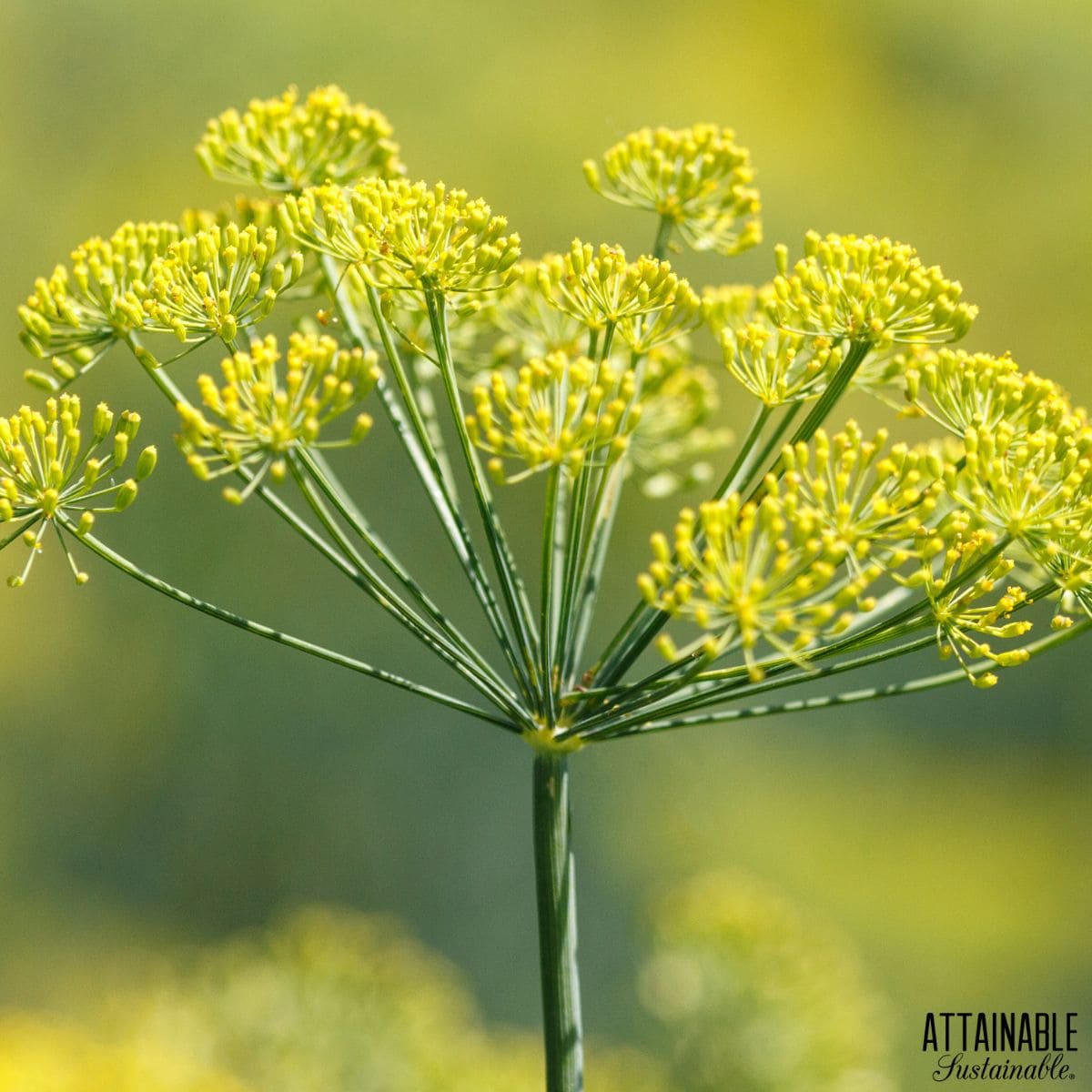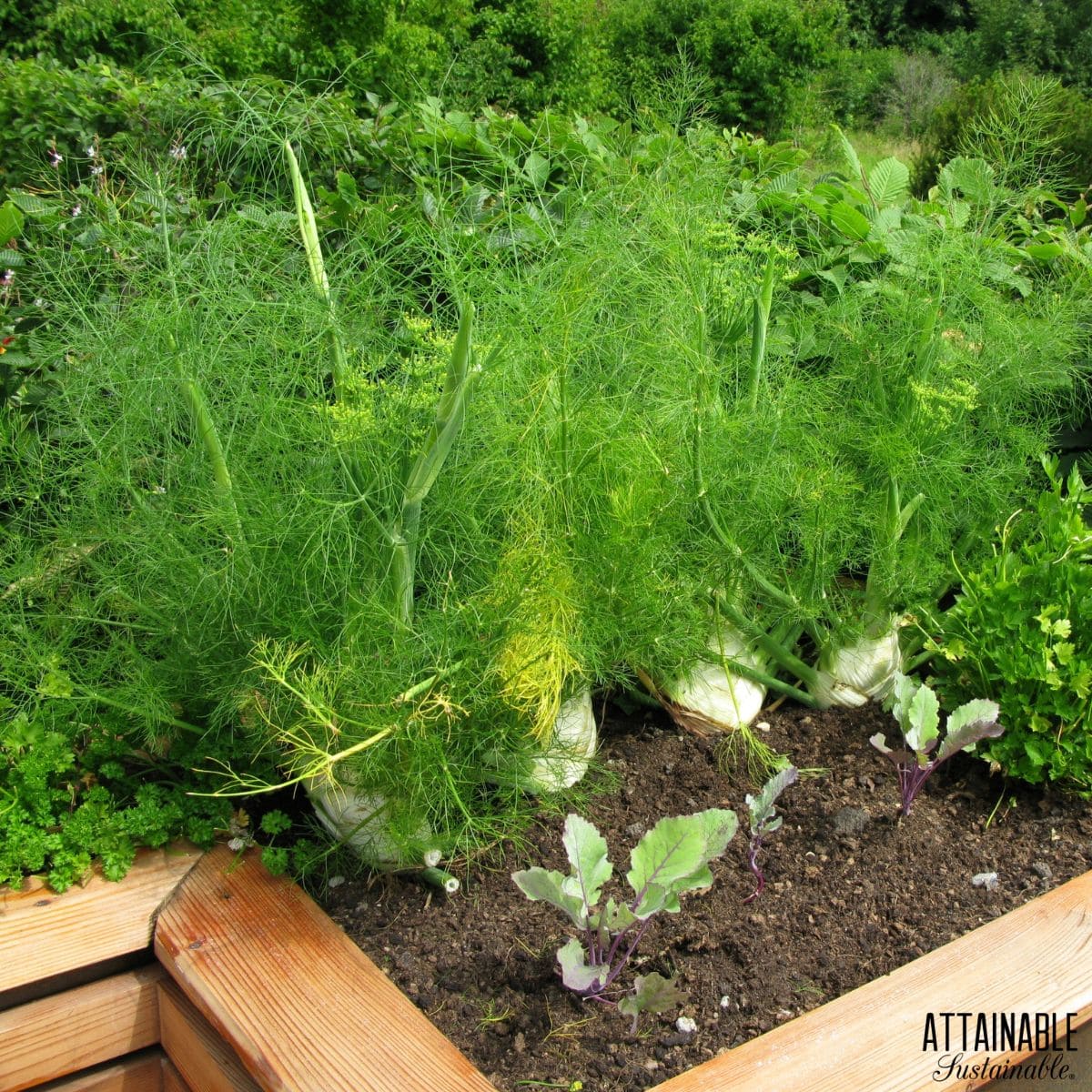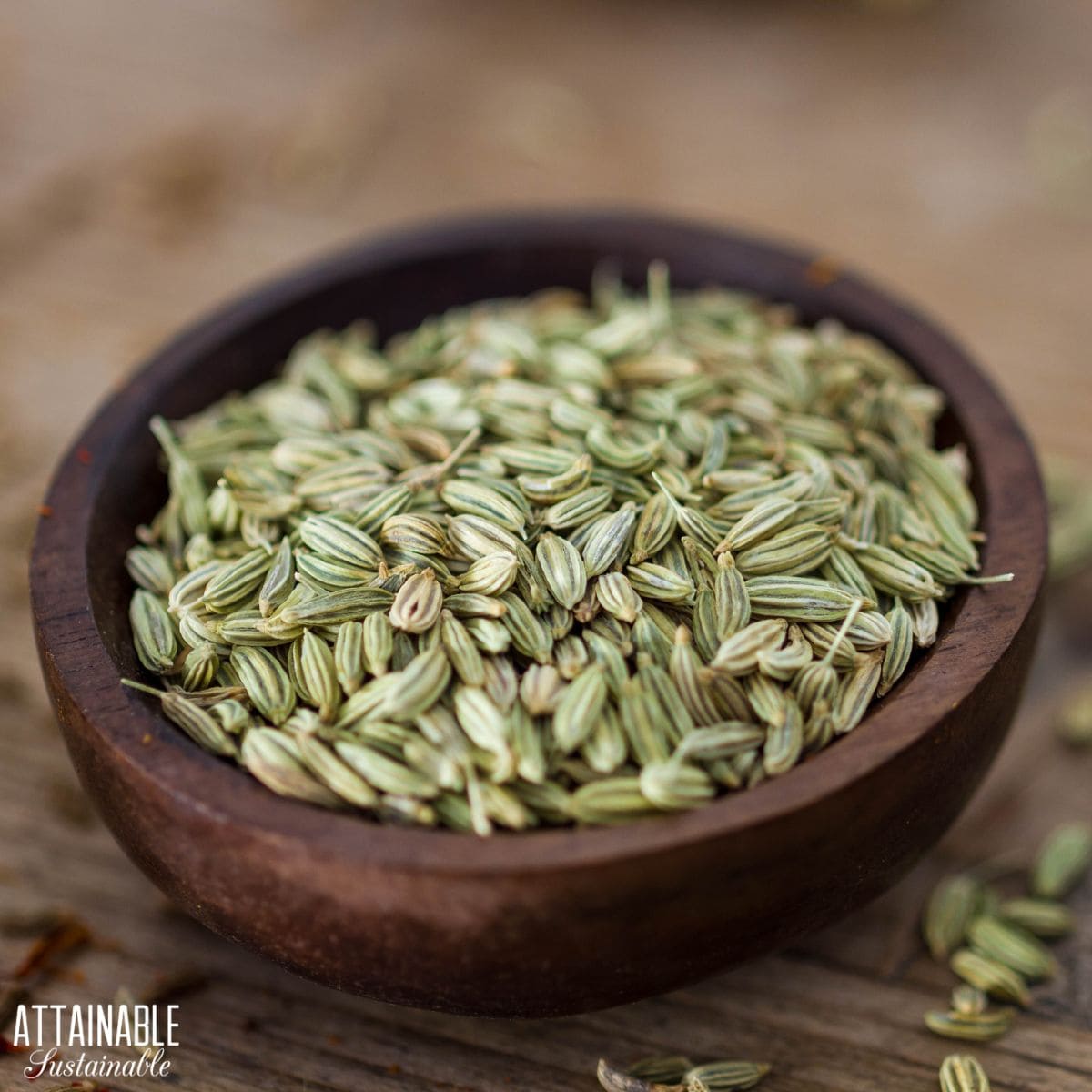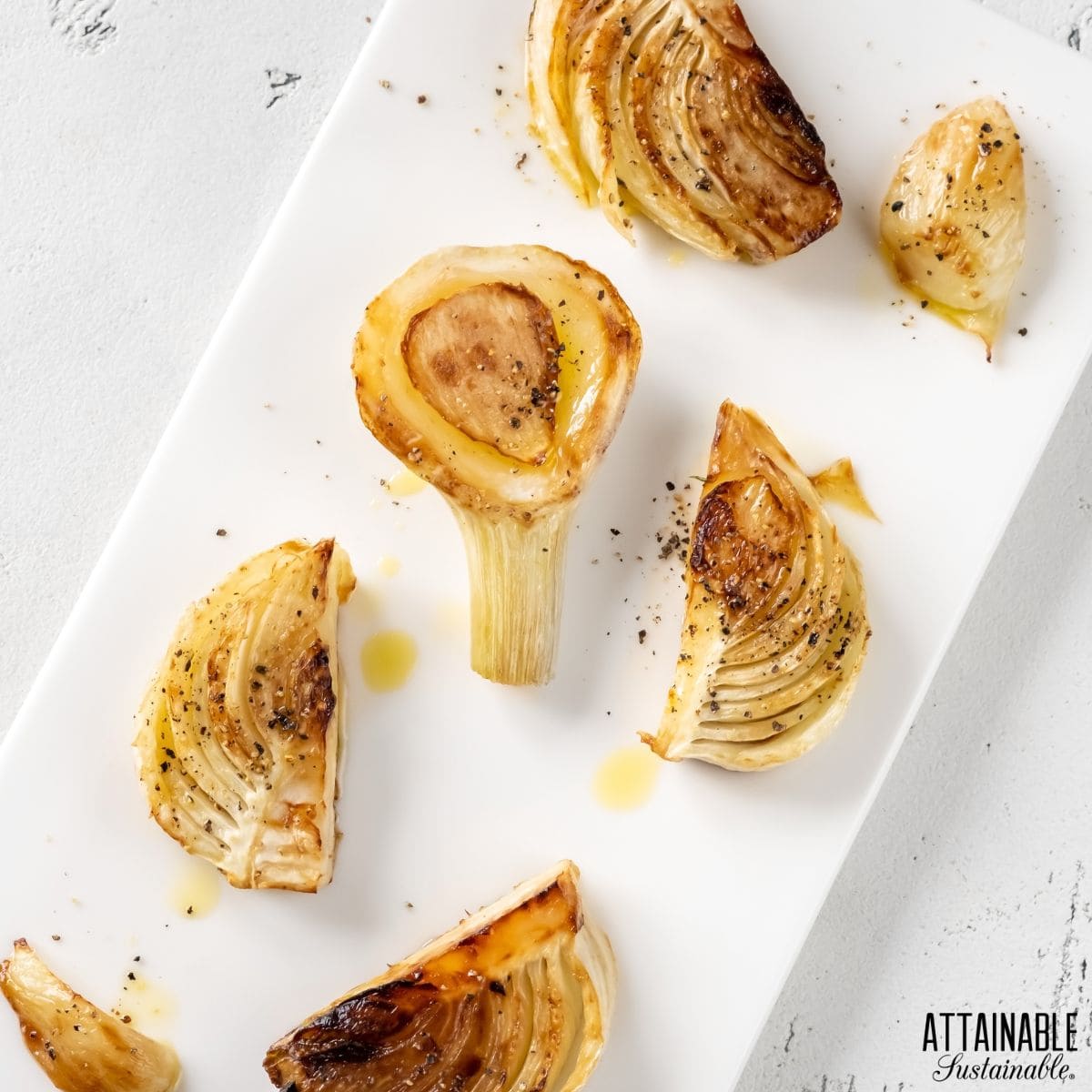Growing fennel is a great way to add delicious leaves, seeds, and bulbs to your kitchen creations. Fennel can be planted almost anywhere in your garden from raised beds, and pots, to your herb garden. Grow fennel for its amazing taste and pretty ornamental look!
Starting an herb garden? Oregano is an essential herb to grow!
Contributed by Jodi Torpey, author and Master Gardener.
 All About Fennel
All About Fennel
Fennel looks a lot like dill growing in the garden. Both herbs have finely-cut feathery foliage, and they grow umbels of small yellow flowers in summer. Fennel (Foeniculum vulgare) could be called a triple-useful plant because the fresh fronds, crisp bulbs, and dried seeds are all edible.
Best of all, fennel plants also attract pollinators to the perennial garden, herb garden, and vegetable bed. Fennel is a biennial plant that can be perennial in some warm climate areas. Plants can grow tall up to 3-6 feet and about 2 feet wide making them an attractive addition to the landscape.
The two main types of fennel include Florence Fennel and Common Fennel:
Florence fennel, also called finocchio, originated in the Mediterranean and has a broad bulbous base that’s used like a vegetable. This type of fennel is sometimes called sweet anise, but the flavor of fennel is sweeter and more delicate than anise. Fennel is rich in vitamin A and contains calcium and other minerals.
Grow Some Greens!
Ready to grow fresh greens, no matter WHERE you live? Sign up for my
FREE quick-start guide and start growing some of your own food!
Common fennel, sometimes called sweet fennel, is the variety that grows the familiar oval, greenish-brown and ribbed fennel seeds. It has edible stems and leaves but plants don’t form into an edible base or bulb and make an attractive addition to the landscape as an ornamental plant.
Note: In some areas, fennel can be considered an invasive plant species because seeds self-sow and spread so readily. Be sure to check the status of cultivated fennel with your state’s Department of Agriculture. Deadheading plants can prevent unwanted reseeding.
Fennel Varieties for Home Gardeners
If you want to grow fennel to harvest bulbs to use in the kitchen, be sure to plant bulbing varieties versus non-bulbing types.
Bulbing Varieties of Fennel
Antares is a hybrid fennel and an All-America Selections vegetable winner. Plants produce 4-5- inch round bulbs. Can grow in containers. 68 days.
Florence is an heirloom variety popular for use in cooking Italian recipes. 90-100 days.
Zefa Fino is an open-pollinated variety that produces bulbs that can be harvested when small (65 days) or mature fennel (80 days).
Finale is an open-pollinated fennel variety that grows 4-inch bulbs; plants are vigorous and resist bolting (75 days).
Non-Bulbing Varieties of Fennel
Bronze Fennel is a beautiful ornamental plant that grows into a host plant for parsley worms that form caterpillars which emerge as swallowtail butterflies. It can also draw other beneficial insects such as honey bees, wild bees, and bumble bees, as well as various types of wasps and flies, all of which can help with pollination in the garden. The lacy, bronze-colored leaves are attractive and edible; edible seeds also form. 65 days.
Bronze/Green Fennel Mix is another non-bulbing perennial with chocolate-bronze to green fronds. The young stalks are edible with large seed heads and plants may self-sow. 65 days.
New to gardening? Limited on space? The 5-Gallon Garden gives you the skills you need to grow food in the space you have. Get started with your garden today!
How to Grow Fennel
In some areas, fennel is grown as an annual, but it can be grown as a perennial herb in warmer zones with mild climates. Plants grow best in well-drained fertile soil in garden beds, raised beds, and even container gardens.
Locate a sunny spot and wait for the soil to warm in late spring. Fennel plants that are grown for bulbs need a long season to grow and form.
If you’re planting bulbing fennel, sow seeds about ½ inch deep and about 4-6 inches apart in well-drained soil, with 2 feet between rows. When plants sprout, give them room to grow and thin to about 10-12 inches apart. Keep seeds moist because they can take a couple of weeks or more to germinate.
Avoid disturbing plant roots to grow the nice round bases for harvesting; take care to keep the soil moist during dry periods.
Requirements for Growing Fennel
Soil Requirements
Fennel requires rich soil. Amend the soil with organic matter, like compost, to make sure the soil has plenty of nutrients and drains well. When new plants start to grow, add a layer of organic mulch to keep the soil cool and moist – the best conditions for growing the bulbs.
Soil temperatures in the 50-75°F range are best for germination.
Light Requirements
Full sun is recommended for growing a good crop of fennel for harvesting.
Fertilizer and Water Requirements
For high-quality fennel bulbs, fertilize plants every 2-3 weeks using an all-purpose fertilizer or liquid fish emulsion solution.
Keep up with regular watering so plants receive at least 1 inch of water each week. Avoid overwatering, though, as this can cause root rot.
Preventing Problems with Growing Fennel
Aphids may be the most likely insect pest on fennel. Watch for aphid infestation in the early summer and wash them away with strong blasts of water from the hose. It may take several applications to get rid of them.
Consistent watering to maintain moist soil is the key to growing the nice size bulbs of fennel. Don’t allow plants to wilt, because they won’t be able to recover.
Growing Fennel in Containers
Fennel can grow in large containers, especially if you select a variety that’s container-friendly, like Antares.
Fill the container with a good quality container potting mix that includes a slow-release fertilizer. Plant fennel seeds as you would in a raised bed and keep seeds moist.
When young plants sprout, thin to allow at least 10-12 inches between plants. Keep soil moist and watch for problems with aphids.
How to Harvest Fennel
Bulb fennel is often harvested in late summer or early fall. Keep track of the number of days until bulbs are mature and harvest when they’re fully formed. When the bulb portion of the plant is 3-5 inches tall, cut it off at the base. The bulb is made up of the thickened base of the composite stalks.
Trim the fennel fronds to the base and carefully lift bulbs from the ground. Save the fronds to use in cooking, too.
Harvesting Fennel Pollen
The pollen of fennel is a popular seasoning and commonly used in the Calabria region of Italy. If you’d like to try it, harvest mature flower heads when the pollen is visible.
Place flower heads into a paper bag and tie tightly with string. Allow the flowers to dry for 1-2 weeks, then shake the bag so that the pollen settles in the bottom. Transfer dry pollen to an airtight container and use as desired in cooking.
Culinary Uses for Fennel
Prepare the bulbs that are crisp white, with no signs of browning or insect damage. Refrigerate, wrapped in plastic, and use within 7-10 days.
For fresh use, the raw bulb — sliced — is a great addition to salads, on an appetizer tray, mashed with potatoes, added to soups, or to use with pasta. You can also braise, sauté, or roast bulbs as a side dish.
The fragrant leaves can be used as a garnish or snipped like dill and used as a flavor enhancer for French cuisine, especially fish recipes.
Fennel seeds can be used to flavor bread, curries, and fish sauces.
Seed Production and Propagating Fennel
Allow flower heads to mature and produce seeds. Cover seed heads with a paper bag tied tightly so no seeds can escape as they dry on the plants. Save seeds in a cool, dry, and dark place until it’s time to plant.
You can start seeds indoors for the next season by planting seeds in individual small pots and covering them with soil. They’ll sprout and be ready to transplant into the garden in late spring.
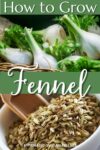
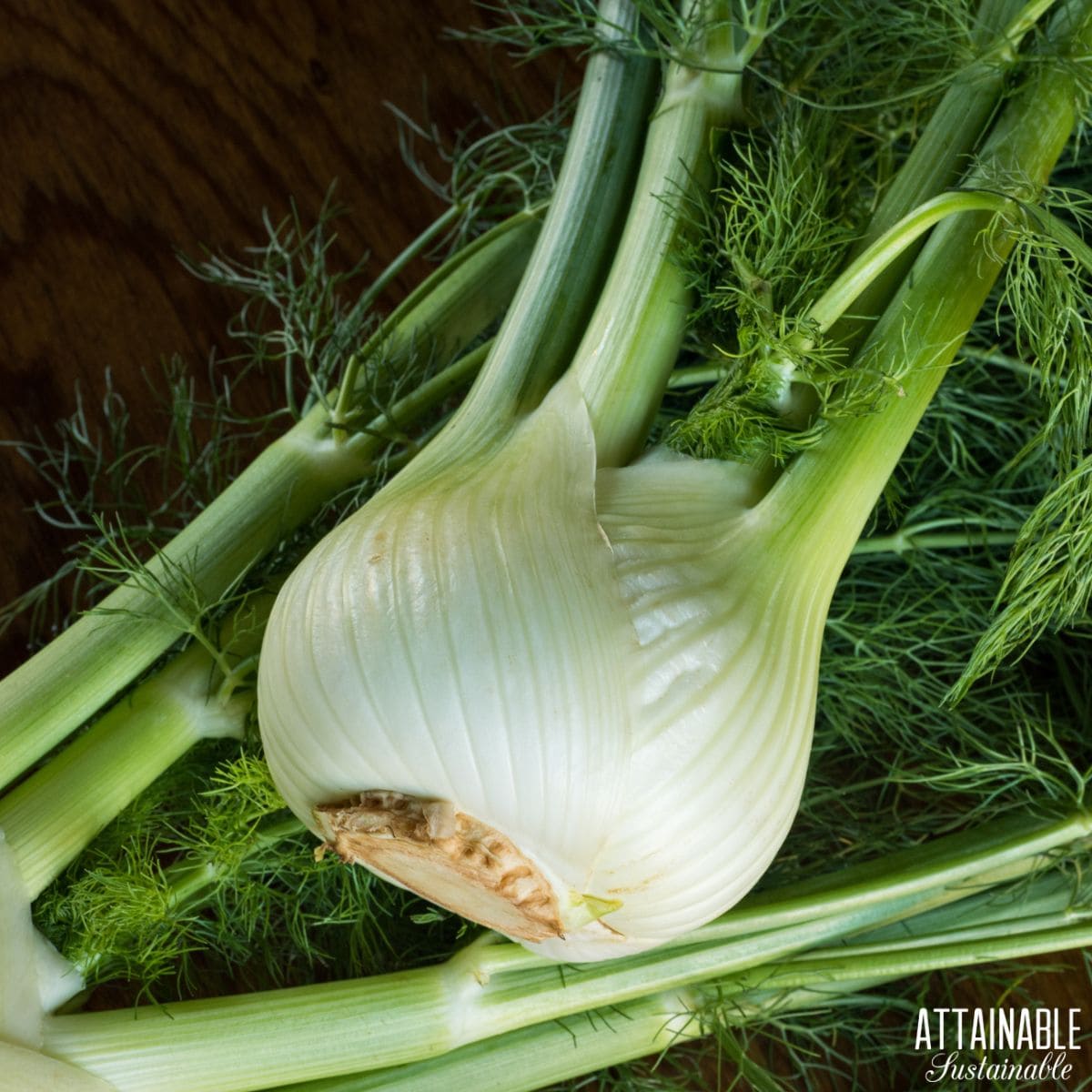 All About Fennel
All About Fennel